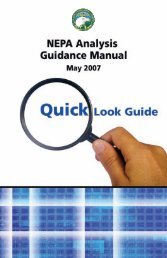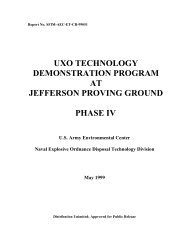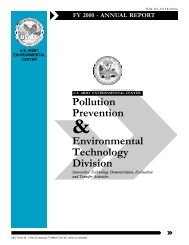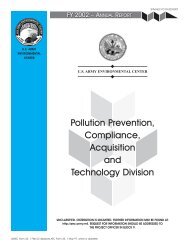(MRAP) Vehicle Program - U.S. Army Environmental Center
(MRAP) Vehicle Program - U.S. Army Environmental Center
(MRAP) Vehicle Program - U.S. Army Environmental Center
You also want an ePaper? Increase the reach of your titles
YUMPU automatically turns print PDFs into web optimized ePapers that Google loves.
<strong>Army</strong> <strong>MRAP</strong> <strong>Vehicle</strong> <strong>Program</strong> <strong>Program</strong>matic <strong>Environmental</strong> Assessment December 2010<br />
<strong>MRAP</strong> production activities occurred inside enclosed buildings. These buildings have floor<br />
drains and sewer systems that connect to the facility sewer system. Personnel involved in<br />
the <strong>MRAP</strong> manufacture and integration followed instructions on the proper method for<br />
filling vehicle fluids. The storage and disposal of any drained fluids followed the<br />
facilities’ requirements and procedures. Responses to any vehicle fluid or fuel spill<br />
occurred in accordance with the facilities’ spill response plans. By following facility<br />
instructions, plans and requirements as well as utilizing the appropriate equipment, the<br />
migration of vehicle fluids to local bodies of water was minimized if not eliminated.<br />
The outside storage of <strong>MRAP</strong> vehicles took place in low numbers at one time and for a<br />
limited duration prior to shipment. The <strong>MRAP</strong> vehicles had a recently applied exterior CARC<br />
topcoat over metal post treatments, and as a result, these coatings prevented heavy metal<br />
contamination of storm water from the <strong>MRAP</strong> vehicles’ metal post treatments.<br />
5.5.2 Testing<br />
<strong>MRAP</strong> maintenance activities occurred during test activities to repair various vehicle<br />
components. These repair activities sometimes required the removal of hydraulic fluid,<br />
engine coolant, and petroleum, oil and lubricants (POL). Appendix D contains a listing of<br />
vehicle fluids. The removal of the vehicle fluids occurred in the test installations’<br />
maintenance bays. <strong>MRAP</strong> vehicle maintenance activities followed TM protocol and the<br />
installations’ spill prevention control and countermeasures plan (SPCCP). The SPCCP<br />
provides guidance on the elimination or control of vehicle fluid and fuel spills. This<br />
includes the use of drip pans, containers and temporary berms to retain loose vehicle<br />
fluids. The use of these pans, berms and containers minimize if not eliminate the<br />
migration of vehicle fluids into the installation sanitary sewer lines and surrounding<br />
bodies of water. When conducting maintenance on the <strong>MRAP</strong> vehicles, personnel also<br />
follow Installation Spill Contingency Plans (ISCPs) to respond to vehicle fluid or fuel<br />
spills.<br />
By following the technical manual procedures and other installation requirements, and<br />
utilizing the appropriate equipment, the migration of vehicle fluids to local bodies of<br />
water was minimized if not eliminated.<br />
5.5.3 Training and Fielding<br />
Training activities require component level repair, which involves the removal of hydraulic<br />
fluid, engine coolant, fuel and oil. Likewise, deprocessing activities sometimes require<br />
component removal and repair. Personnel involved with the removal and repair of<br />
components, which contain vehicle fluids, follow TM instructions. These instructions are<br />
written to minimize, if not eliminate, the migration of vehicle fluids into the installation<br />
sanitary sewer lines and surrounding bodies of water. The removal of component fluids<br />
from the vehicles occurs in areas with hardened floor surfaces. When conducting repair<br />
activities, personnel also follow procedures specified in <strong>MRAP</strong> TMs as well as installation<br />
UNCLASSIFIED 34







